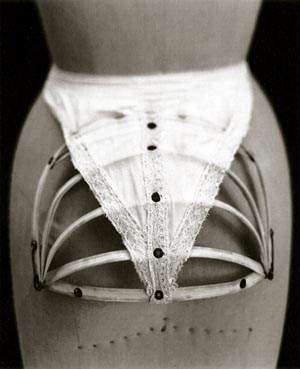spring/summer 2006, no. 7
Tanya Marcuse
Undergarments and Armor
With the support of a Guggenheim Fellowship, I traveled to archives and museums in the U.S. and England photographing undergarments, armor, and the museum forms that populate the storerooms—objects like breastplates, helmets, corsets, bustles, mannequins and dress forms. The earliest objects date to the 14th century while no object is dated past 1900, ruling out the possibility of a living owner. I see these garments and suits of armor as sculptures of the body that, like a carapace, outlast their wearers. These personal effects adorned, constricted and protected the body all at once. Now they are archived as artistic and cultural artifacts, shells of the bodies that once inhabited them.
While visual and conceptual dichotomies are clearly present in the relationship between the undergarments and armor (male/female, hard/soft, outside/inside, armed/disarmed), no one simple reading is possible. A bustle is an industrial contraption, while a breastplate is delicately adorned. In the 14th century the term corset was used to refer to a breastplate as worn by a soldier. And though one might expect the feminine undergarments to be alluring, they often appear clinical, even dingy, divorced from the body’s lingering presence. On the other hand the armor often conveys an aggressive sexuality, both gorgeous and cruel. Yet in both cases the garments are transformative. The undergarments enhancing and constricting the body to support the fashion of the outer dress; the armor shielding the body’s mortal flesh, while concurrently turning its wearer into a terrifying war machine.
The museum forms are an important part of the body of work, both because of and despite the way they make the project less tidy. At the Museum at the Fashion Institute of Technology a pile of foam and knit torsos, constructed for their famous exhibition on the corset, lie in a heap on a metal cart. In the conservation room at Higgins Armory Museum, fragments of armor line the shelves, while in the center of the room stand mannequins marked “military man.” Fifty helmets, wrapped in clear plastic, cover folding tables in the room next door. These all too surreal surrogate bodies are tangible reminders of the absence of the living individuals that once owned and wore these garments; the strange fibrous and plastic materials that appear here and there in the photographs tie us to the present, and interrupt any simple nostalgia.<
Tanya Marcuse has received awards and honors including a 2002-3 Guggenheim Fellowship, a 2003 Anson Kittredge Grant, a Thomas J. Watson Fellowship, as well as fellowships from the Center for Photography at Woodstock, and the Dutchess County Arts Council. Her photographs have been exhibited widely, and her work has been written about in the New York Times, New York Magazine, the Village Voice, Artnews, Photo-eye, Photography Quarterly, Art in America, PDN, Art Issues and Artforum. Her photographs are in the collections of the Corcoran Museum of Art, The Metropolitan Museum of Art, The Yale Art Gallery, The Library of Congress and numerous private collections. Tanya currently teaches photography at Simon's Rock College of Bard. A book of her project, Undergarments and Armor, has recently been released by Nazraeli Press. The project is the recipient of the 2005 JGS book project award. She earned her MFA from Yale University School of Art.

